You’ve probably realised by now that I like thistles, oops, cathedrals. I was brought up on them, and castles and stately homes and have a very happy memory of going with my father to an old house in Kenilworth where we lived at the time, so I must have been under 11 years old, as it was going to be knocked down. My vague recollection is that it was given way to a new shopping centre. It was timber framed medieval and very dilapidated and I remember that Dad found an iron hook that would have been on the end of a long wooden pole that was used to pull burning thatch down in a fire, and an incredibly crude and simple wooden plough, probably for one person, plus or minus a horse or another person, to pull through a very small holding, hardly more than a garden I’d guess. Oddly, I saw two men using something only a little more sophisticated, iron shod but otherwise just the right branched bit from a tree with the right angle to give the two limbs of the plough. So I’ve been a “scientist” in many ways, but a lover and respecter of history.
Hm, running with the memories, I can also remember coming home from med school and going with Dad to a local dig where by-pass road construction had hit a burial site. I’m not sure how old now, but pre-Roman. I knew enough, and was enough that scientist by then, to pronounce one fairly well preserved skeleton with an essentially intact pelvis and femurs, of a young adult male. The scientist at that point was winning over the humanities.
Well, this is a bit pertinent because the cathedral here, even after Burgos, is amazing and like nothing I’ve ever seen. I know that as it’s the end of the journey, I had a need somehow to do it justice, to look at it and try to take it with respect and appreciation and boy it’s a challenge that’s really taken three bites, so the title here should perhaps be “Santiago de Compostela Cathedral (II)” as I actually started trying to get to grips with it in that mad arrival two days ago when the processions outside seemed far more pagan than Christian. I don’t suppose there’s much doubt that would be pre-Christian habitations here: it’s a strategic hill and clearly in fertile countryside and sitting between the sea and the rising Galician hills I’ve come through. However, I’ve seen no comment on pre-Christian findings. It is known to be the third church/cathedral on the site though and it’s essentially an accretion of vast amounts of baroque and classical on top of a glorious, and huge, romanesque cathedral, with very little true gothic addition.
Yesterday I walked back up to the Obradoiro square to find that carnival and basketball had been replaced by … a classic car show. On a Sunday, outside the most grandiose place of worship, probably between here and Barcelona! It’s clear to me that the Spanish do things their own way and good for them but to a staunch cyclist and, to a large extent, an opponent of the infernal combustion engine, and particularly those that honk tunes as these were, it was a challenge. However, there’s that side of me that likes to see things preserved, kept going and used and that likes to see eccentricity respected. This had all that in trumps:
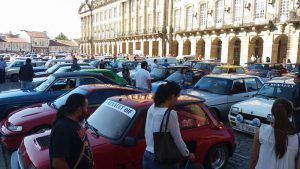
The West front of the cathedral, where Toto had cowered the day before, is to your left, the cars were lined up like some congregation but, as the day before, I think the gods being worshipped here aren’t in the Bible. You can see the foot of the great baroque front behind this lovely little number.
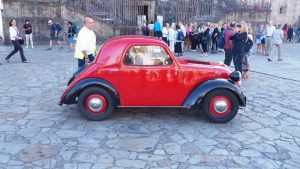
In my yoof, well in my twenties, I did have a romantic yen for one of these. I and a girlfriend hitchhiked across the channel in one years ago
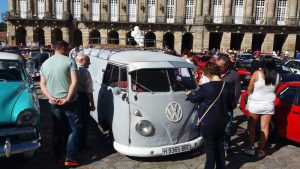
Here’s the whole automobile congregation lined up in their pews. I’m on those steps up to the elevated entrance on the west front, which is currently closed for renovation meaning that I couldn’t see the most glorious romanesque doorway which the baroque one essentially hides completely, but also, to be fair, protects.

After a bit, with a cacophony of horns, they were off:
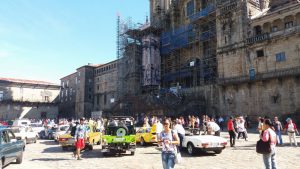
And within 30 minutes the square was back to a completely different state. Crusty jugglers, (OK, with apologies to Hot Fuzz, I agree, they’re not jugglers.)


And exhausted but very, very, happy pilgrims. (I am cheating a bit, this was today, but there were similar scenes, though it was almost too hot to lie down like that, yesterday.)
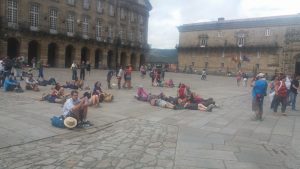
The original romanesque cathedral is cruxiform with an ambulatory round the choir and lots of chapels, but it has been so added to, particularly externally, that it’s at first almost impossible to feel that heart and it has more the feel of a rather misshapen huge quadrilateral affair with four squares on each face, of which Obradoiro, the stonemason’s square, is the biggest. Yesterday I think I did a mix of cirumnavigating it and going through it.
Here’s the next (South) square:
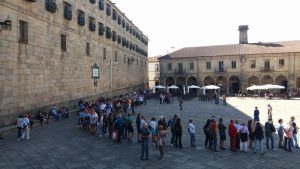
That queue, and a lot more of it to the right, was the queue of pilgrims waiting to filter through behind the altar and hug Saint James. That’s a monastery turned nunnery on the left and I forget what that building is opposite, the cathedral is on the right, out of shot but has glories like this:
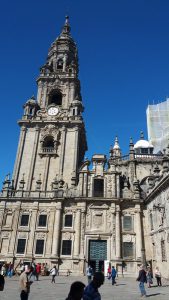

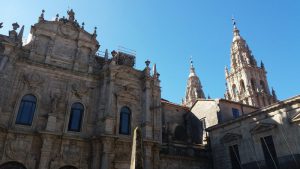
It gives the sense of a city of towers and lesser spikes and cupolas and roofs.
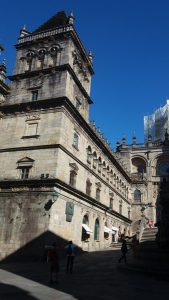
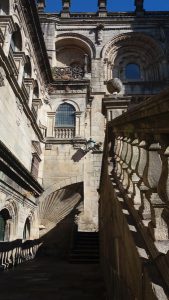
See the pilgrim’s scallop shell?


And stars from the legend of the star showing Pelagius (? check some time!) the long lost tomb of James. (Compostela could be from “field of stars” but probably isn’t, probably comes from “good place”)
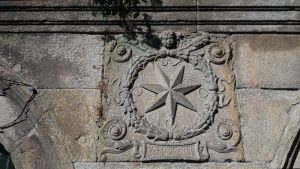
There’s the heraldry that’s such a feature of gothic and later Spanish ecclesiastical (and lay grand) architecture.
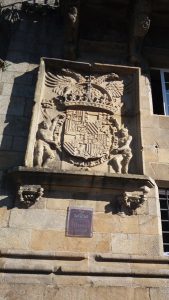
And it goes on, with small hills of steps between squares (French bike pilgrims but with very little load, where had they put their things?)
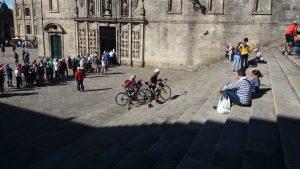
Through two more, each quite different, squares.
But inside it’s very different. It’s pretty immediately obvious that the traditional cruciform shape is there, and the main vaulting is simple, beautiful, and seemingly almost untouched, romanesque.
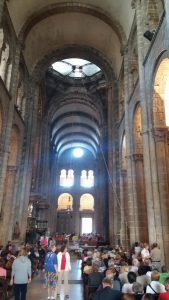
(The crossing is a dome, I suspect that’s later but almost all the vaulting otherwise is simple barrel vaulting.)
The place was packed and it was coming up for time for the third mass (I think) of the day, the midday mass, so I opted only to dip in feeling it belonged to believers. I gather from my Australian friend (I do hope she got a bus to Finisterre), that had I stayed I’d have seen the famous but fairly infrequent sight of he enormous censer being swung back and forward so it is said to reach 40kph. The argument goes that it used to be vital to drown out the smell of the pilgrims. It’s the largest in the world and carries an enormous load of burning charcoal and incense. I’m a little sorry I missed that but it seemed to me that most of the hundreds and hundreds in there looked like believers and I do think it was for them…
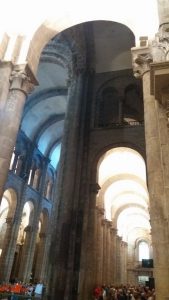

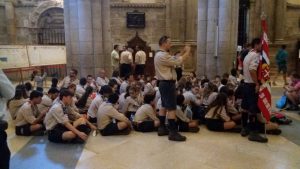

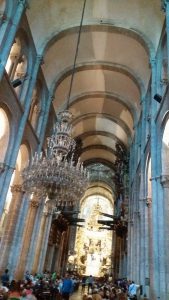
Those aren’t gun turrets just before the crossing, those are organ pipes in what seems to be a very common baroque addition in these Spanish cathedrals, often with a bizarre (to me) relocation of the choir to that point, fortunately not done heere. However, you can see that the baroque period spared no gold paint or decoration up in the choir and on the huge altar.
As ever there are the stages of the cross and umpteen other depictions of pain, Christ’s and others’.
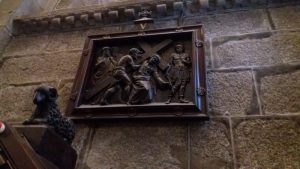
And there’s a, to me, disturbing theme of the martial church:

Well of course there is, that in many ways is what created the importance of Saint James and his (eponymous) location here in Santiago. That is Santiago Matomoros: slayer of Moors who was invoked in visions to inspire some of the “reconquista”: driving the Moors out of Spain. His other forms, as pilgrim and carer/hospitaler come later. Above that is this:
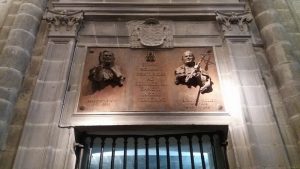
Which helped remind me that, though we seem to have a rather different Pope at the moment, the political side of Catholicism is, of course, crucial.
I came away with mixed feelings. The original cathedral is glorious: I think it’s the biggest romanesque cathedral I’ve seen and it’s huge and, to me, harmonious, extraordinary, a testament to the beauty humans can create and to the way they can do it so it can survive for centuries. (The main central cathedral was finished in about 1212 if I remember rightly.)
Although the classical and baroque additions don’t move me in the same way, and they do form a very odd mix with the romanesque, somehow it really seems to me to work and some of those towers and stonework from the later periods wowed even a heart hardened against their traditions and extravagance as mine is.
I also found the numbers of people there moving. Most seemed to be there for quiet celebration but what do I know of their feelings.
There is this running current of an almost perverse savouring of suffering that sits very uneasily with me but which I also find myself respecting as not dodging that life can be full of pain and suffering for many, even without us doing anything to them or to make it worse, and also it seems to respect and recognise the truth that humans do hurt one another, horribly, and often glorify that, even, in various ways, take satisfaction, even pleasure in that. Any world view that tries to avoid that seems to me to be cowardly and unhelpful.
However, the celebrating of that side of humanity seems to me to get woven in with hatred of the other: the crucial, crusading, side of Saint James and too much that Christianity has done. And of course, I’m not saying that Christianity is alone in that, and we know, e.g. from the treatment of the Rohingya now, or the rise of radical and deadly Hinduism, that this isn’t the sole province of the three massive monotheisms either. I guess I can’t complain if I’m saying these things are simply in us as we are and seem to have been for millenia. But I long for something more benign even if that is, in my own words, perhaps cowardly and unhelpful.
I left the cathedral to the believers yesterday and came back for a second go at it today and I think I can have a stab at that before I turn in for my last night on the road.